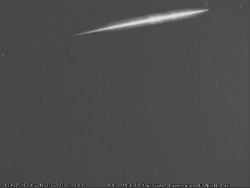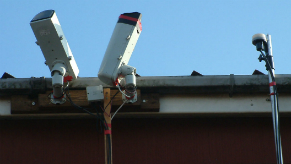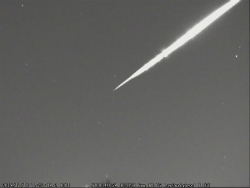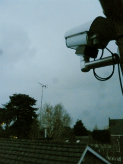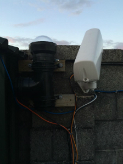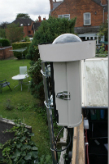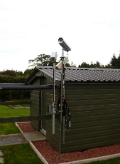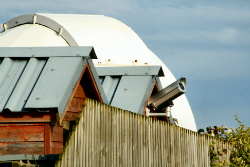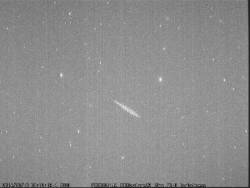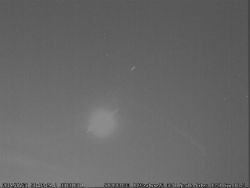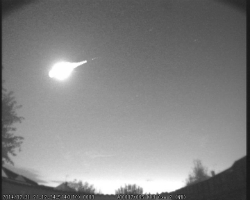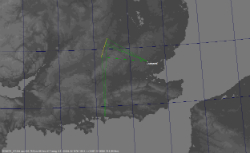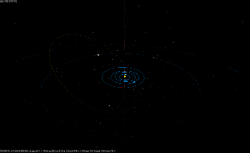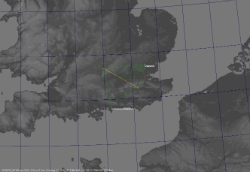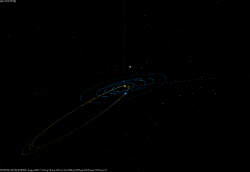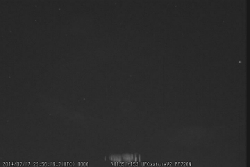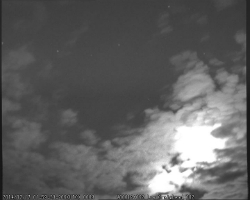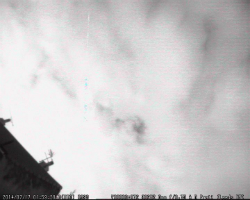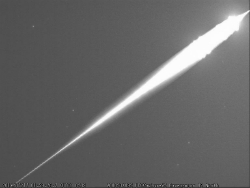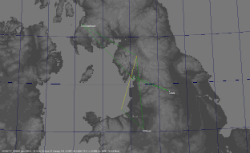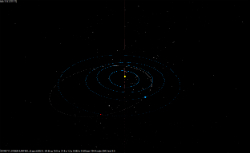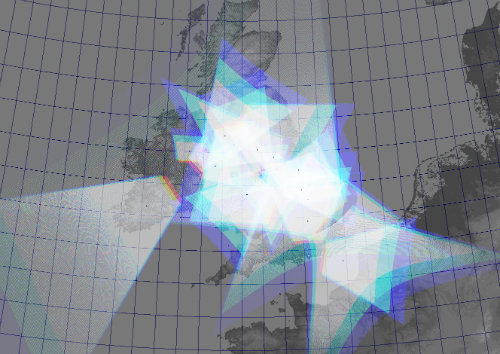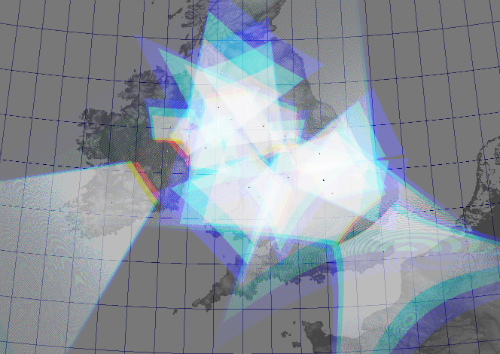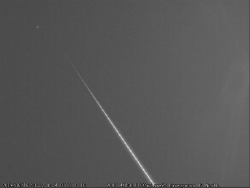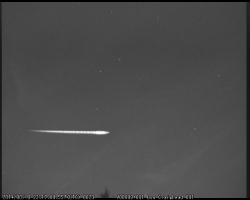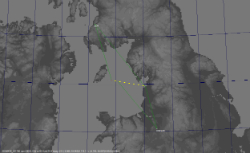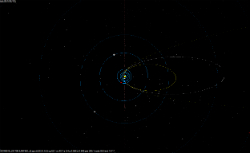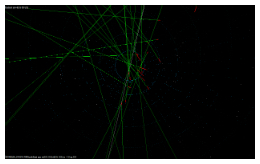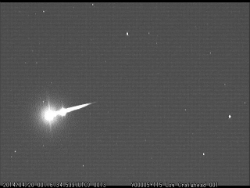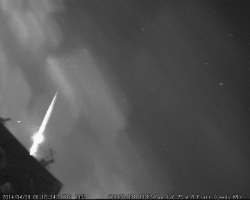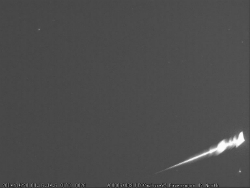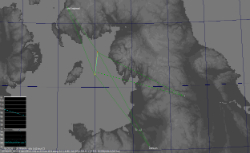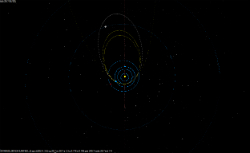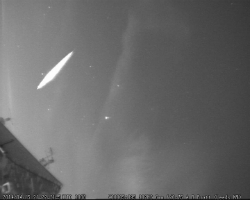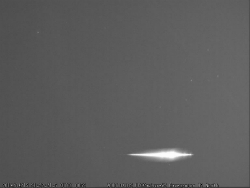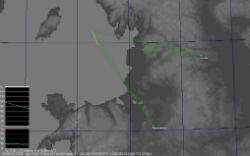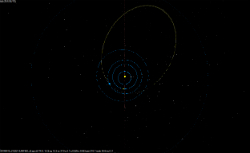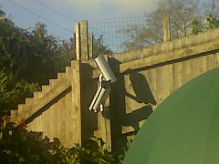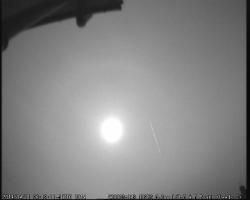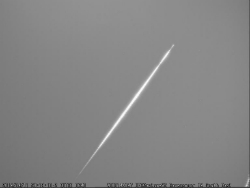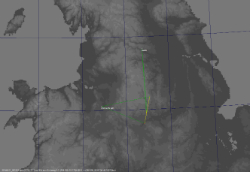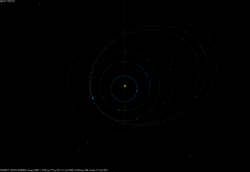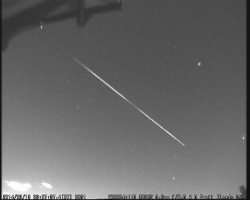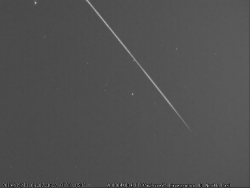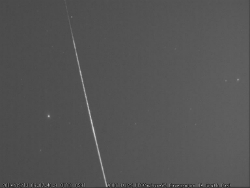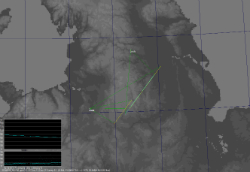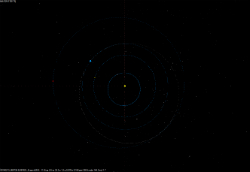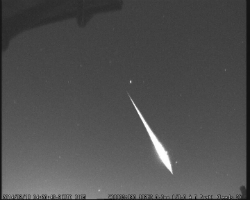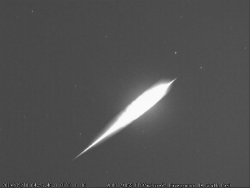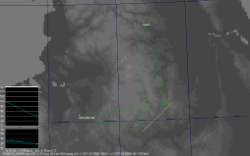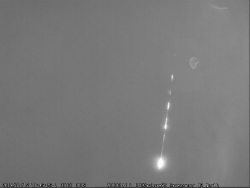Welcome to NEMETODE
Network for Meteor
Triangulation and Orbit Determination
Home: 2014
NEMETODE is a network of cameras based in the British Isles that monitor the night sky for meteors ("shooting stars"). Through the use of triangulation and timing the network is able to determine the actual trajectory and velocity of the meteoroids as they pass through the Earth's atmosphere. From this we are able to determine specific characteristics such as the radiant (that point in the sky from which each meteor appears to originate), how the position of this radiant varies with time and the parameters of the original solar orbit of the meteoroid (before the earth got in the way). We analyse our own data as we find this is an excellent feedback mechanism that deepens our understanding of the subject and enables us to optimise our detection capabilities. Our results are published in peer reviewed journals such as the Journal of the British Astronomical Association and WGN, the Journal of the International Meteor Organisation. Having completed our analysis, our data is uploaded to EDMOND for consolidation with other European groups. While we have excellent coverage over certain parts of the British Isles, there are still many gaps so please get in touch if you are interested in joining the group.
This page is the archive of the 2014 entries on the NEMETODE homepage. Other years can be accessed by clicking on the links below.
15th December 2014: "Always Check your Backgrounds": Is common advice from professional photographers and the NEMETODE team always take a good close look at their images. And so it was in the early hours of 13th December 2014 in the lead up to the Geminds maximum that one of our brighter captures of the night was photo-bombed by the expanding plume of an in-orbit propellant dump from a recently launched rocket. Click on the image below for more details.
09th December 2014: NEMETODE's 2012 Dataset is now available: The combined .csv file encompassing all meteor observations recorded by the cameras of the NEMETODE network during the period 01st April 2012 to 31st December 2012 is now available here. Although the first node of the NEMETODE network (Ravensmoor) went live in October 2010 (see Overview & History) it was not until April 2012 that the second node (Leeds) came online, hence the choice of start month for this dataset. During this period there were 4068 individual meteor detections with 317 "Q1 Level" common events from three stations and five cameras. Thanks as ever to all the contributors who have collected and analysed this data and who have agreed to make it available.
09th December 2014: Meet the Team: Although we are the largest video meteor network operating in the British Isles (currently 18 stations operating 30 cameras ... with more due online soon), it's very important to recognise that our observers are people (as opposed to numbers) ... for that reason we've updated the Overview & History page to provide some additional background on the team members - we'll be updating the page with additional imagery as it comes in but please take a few moments to have a look - we're a very diverse bunch!
07th December 2014: Hot off the Press: Our latest paper "Taurids 2012 - Dual-Station Meteor Videography" has just been published in the December 2014 issue of the Journal of the British Astronomical Association - a .pdf is available here. As ever all our previous papers, plus lots of additional information, is available on our Scientific Results page.
20th November 2014: Allan makes it 30: The recent rapid growth of the network continues as Allan Carter deploys a pair of cameras from his home in Basingstoke, Hampshire. Both make use of the very sensitive Watec 910HX/RC. The first uses a Computar 2.6mm f1.0 lens and faces south / south-west while the second is coupled to a Computar 6mm f0.8 lens pointing north-north-west. Welcome aboard Allan ... with 30 active cameras in the network, meteors are now having extreme difficulty evading detection!
19th November 2014: Fireball(?) over Northern Ireland: Last night (18th November 2014) at 17:27:04 GMT a bright meteor (potentially a fireball) was widely observed from Northern Ireland as reported on the BBC and on the Armagh Observatory Fireball Reports page. While some of the NEMETODE team were clouded out, David Anderson in South Ayrshire captured it. We're still working with other members of the team to confirm whether or not they bagged it. Initial analysis suggests it first became visible between the north coast of Wales and the Isle of Man then travelled north west, passing to the north of Belfast and over Co. Antrim. Additional details to follow as they become available but in the meantime David's video is available below.
Latest Update 20th November 2014: With most results now in, it appears that all other automated cameras covering this part of the country were either clouded out or, due to the relatively early hour, had not yet been activated. As a result it appears that David's video is the only recording of the event. Please get in touch if you are aware of other recordings.
17th November 2014: NEMETODE Grows Again: We're very pleased to announce that Karen Holland has joined the network with the deployment over the weekend of her Watec 902H coupled with a Computar 6mm f0.8 lens. Aligned to the south-east from Moulton, Northampton this system, the 28th in the network, provides additional coverage towards the English Channel, overlapping with cameras operated from Chelmsford and Chichester. Please join me in welcoming Karen to the group - all we need now are some clear skies!
11th November 2014: A Different Michael, another All-Sky Camera: Michael O'Connell has confirmed that his all-sky camera is now operational. The image below shows it in its custom housing alongside the previously deployed 8mm f0.8 system. Michael's new system is based around a Watec 902H2 Supreme coupled to a Comptar 2.6mm f1.0 lens. The huge field of view provides coverage over essentially the whole island of Ireland and is the 27th camera contributing to the network.
04th November 2014: Michael's All-Sky Camera Comes Online: Michael Morris has confirmed that his all-sky camera mentioned in the 01st September 2014 update (see below) is now up and running. Based on a Watec 902H2 Ultimate camera with a Computar 2.6mm f1.0 lens it becomes the 26th camera contributing to the network.
01st November 2014: NEMETODE Hits a Quarter Century: Just in time for what many observers consider to be the best time fo the year for meteors, Mike Harlow from Bucklesham near Ipswich in Suffolk has joined the network with his Genwac 902H Camera fitted with a Computar 6mm f0.8 lens. The deployment of this 25th system in the network provides excellent coverage up along England's eastern coast and the western parts of the North Sea. Please extend a warm welcome to Mike - as ever we're all looking forward to the results that his data will yield. Stay tuned too for additional updates as further systems are currently in the process of being deployed.
09th October 2013: Blue Jets Column Sprites over the Isle of Man: During the night of 06th / 07th October 2014 cameras of the NEMETODE network operated by Graham Roche (Dublin), Michael O'Connell (Co. Kildare) and David Anderson (South Ayrshire) obtained multi-station captures of Column Sprites Blue Jets, a type of Transient Luminous Event that occurs high above a thunderstorm at altitudes of around 80km. Initial imagery is shown below ... click on the pictures to view larger versions, videos. Being multi-station observations, triangulation is possible and we're currently working through the details of the Column Sprites' location and altitude with respect to the progenitor lightning discharges. More to follow but in the meantime congratulations to Graham, Michael and David for their remarkable observations - in particular the earlier event may be the first time such an phenomenon has been imaged from three seperate locations within the British Isles.
06th October 2014 23:33:35 GMT: The top row of images shows Graham's view from Dublin, the second row Michael's imagery from Co. Kildare and the third row David's capture from South Ayrshire. Larger images on the left, videos (cropped and slowed down by a factor of 10) on the right. The bright blob to the right hand side of David's images is the (overexposed) moon. Note the progenitor lightning flash that occurs just before the Column Sprites appear. In addition, on Graham's video, note the bead (interrupted column) on the left hand sprite. |
||
07th October 2014 00:21:46 GMT: The top row of images shows Graham's view from Dublin, the second David's capture from South Ayrshire. Larger images on the left, videos (cropped and slowed down by a factor of 10) on the right. The bright blob to the right hand side of David's images is the (overexposed) moon. Note the progenitor lightning flash that occurs just before the Column Sprites appear. |
||
All images and videos are available for individual personal use. The copyright resides with the authors and their written permission must be obtained in advance of any public and / or commercial use. |
||
03rd October 2014: Workshop Update: The BAA/NEMETODE Meteor Section Workshop Meeting held in Birmingham on the 27th September 2014 proved to be a great success. I echo all of the organisers and contributors when I offer my sincere thanks to thanks to everyone who attended for giving up their time to come along, engaging in open, productive discussion and for their positive feedback after the event. In addition to putting faces to names, there was a wealth of on-hand experience and knowledge mixed with lots of debate that helped to tease out answers to some challenging questions.
Being a workshop (as opposed to a meeting - see agenda) much of the value was in the discussions themselves (as opposed to the slides / documents that were shown). Over the past few days I've amended some of the presentation material to include elements of what was discussed (hence the delay in delivering this posting). Over the coming weeks this website will be updated to include further technical details related to what was covered but in the meantime the main slide deck provides an overview of what was used to initiate the discussions. In addition we have the slides from Alex on UFO Capture and UFO Analyser. Enjoy, feel free to get in touch with any questions, and stay tuned for further updates. As a taster, the MS Excel template for analysing the output from Dimension 4 (commonly used for applying time corrections to PCs) is available here.
5th September 2014: David Deploys Another: The 24th camera in the network is now active with the deployment of a third unit by David Anderson. This one faces north-west from David's observatory in Low Craighead, South Ayrshire and monitors the same volume of atmosphere over towards the Isle of Skye as is covered by Denis Buczynski. As far as we know, this is the first time a common meteor layer has been observed over Scotland by observers based within Scotland. Somewhat ironically this camera alignment is similar to that which David was observing when he caught the fireball of 14th October 2013 which is the subject of an upcoming paper. Soon after this event David swung his camera around to the south in order to triangulate with existing members of the NEMETODE team but since then he's augmented his setup with additional units. Congratulations to David - his cameras are prompting some puzzled glances from the locals!.
01st September 2014: 23 and Counting: Today we're pleased to announce that Michael Morris, another very capable observer based in Worcester, has joined the network with a Watec 902H and a 6mm lens. The lifts the total number of active systems up to 23 and provides welcome coverage over a gap that we had over part of the Irish Sea to the south-east of the Isle of Man. Some of you may recall that Michael has had a widefield system in operation for a number of years, data from which played a key role in the investigation of the UK Fireball of 30th March 2013. Michael has also recently upgraded this system too and is working through the commissioning phase. Please extend a warm welcome to Michael - once again we're all looking forward to the results that his data will yield. Our latest meteor layer map showing all 23 cameras is available here.
10th August 2014: And Denis Makes it 22: Up on the Tarbat Pennisula, just to the north of Portmahomack, it is only now that the sun is dipping low enough below the horizon for astronomical observations to recommence after the long summer hiatus. Last night Denis Buczynski began commissioning his new meteor camera and in spite of the less than ideal conditions (twilight and the full "super" moon), he managed to bag a few meteors, including this Perseid. Still some fine tuning to do but seasoned observers will recognise the stars of Andromeda and Triangulum ... a closer inspection to the upper right of the image also reveals the faint smudge of M31, the Andromeda Galaxy - testament to the powerful combination of the Watec 902H camera and Computar 12mm f0.8 lens that Denis has deployed. This system lifts the total number of active units in the NEMETODE network to 22. With additional deployments imminent, we're expecting to increase our triangulation coverage into the far north of Scotland in the very near future. Welcome aboard Denis!
30th July 2014: The orthogonal observing azimuths of the Chelmsford / South Downs Planetarium combination is proving to be remarkably effective as they both imaged another spectacular on 31st July 2014 at 22:12:24 BST. While there's still some work to do to optimise the video settings, the results show what can be obtained even during the "bedding in" period. Really looking forward to seeing results from the Perseids from which were already seeing enhanced activity. This particular event was a magnitude -2.3 sporadic and, as Nick remarked, would have been overhead for the concrete cows in Milton Keynes.
All images and videos are available for individual personal use. The copyright resides with the authors and their written permission must be obtained in advance of any public and / or commercial use. |
||
30th July 2014: High over Heathrow: Our newer deployments have been having some notable successes, particularly now that meteor activity is picking up as we progress into the second half of the year. A recent notable example was this magnitude -2.9 sporadic that passed over south-west London on the 26th July 2014 at 23:13:59 BST. The trail was so long that it was picked up by both of Nick James' cameras in Chelmsford, even though they face in opposite directions. One of the two cameras at South Downs Planetarium also detected it, allowing us to estimate the ground track and orbit. This Google Earth file shows how the ground track clipped the north-east corner of Heathrow Airport ... no hazard to passengers - meteors typically burn out at an altitude that is seven times higher than that at which passenger jets cruise.
All images and videos are available for individual personal use. The copyright resides with the authors and their written permission must be obtained in advance of any public and / or commercial use. |
||
26th July 2014: Sprites in Print: Our latest scientific paper, "Recordings of 'Sprites' by Video Meteor Detection Cameras" has just been published in the August 2014 issue of the Journal of the British Astronomical Association. This paper relates to the July 2013 NEMETODE sprite observations. The images, by their nature, are relatively faint, particularly when seen on the printed page - electronic versions are available on our Sprites page while our previous papers (and details of upcoming ones) are available here.
19th July 2014: Carrots off the Cork Coast: Depending on your perspective, the British Isles have recently been blessed or blighted with a number of violent and in some cases long lasting thunderstorms. The extensive coverage of the NEMETODE network meant that there was a reasonable chance that sprites resulting from these lightning discharge events could be captured and the team kept a close eye on their images. Hundreds of lightning flashes were recorded, including a lightning bolt observed from Ravensmoor. However the first to bag a sprite this time around was Gordon Reineke, observing from Newbridge in Co Kildare. He imaged the tops of three different groups of "carrot" sprites that occurred off the coast of Co Cork, approximately 300km to his south-west on the night of 17th / 18th July 2014 at 23:56:16, 00:06:04 and 00:11:22 (all times BST). Further details are available on our Sprites page. Congratulations to Gordon who has only recently deployed a camera and joined the network!
17th July 2014: Getting Lucky on the First Night: As described below, David Anderson's second camera last night became the 21st active camera in the NEMETODE network. It was a late night for David as he was up until midnight troubleshooting a minor electrical connection issue on the system prior to going to bed. As luck would have it, David's skill and perserverence paid off as his latest deployment was up and running in time to catch a rather bright meteor on 17th July 2014 at 02:59:26 BST. This maginitude -5.6 sporadic fireball came in just to the east of the Isle of Man and exhibited a number of terminal flares (bright flashes, just before it disappeared from view). The earlier stages of its flight were within the field of view of David's first camera though intervening clouds prevented it from being detected, an issue which prevented other NEMETODE cameras from picking it up. We ended up getting it on three cameras: Alex from Leeds imaged it through extensive cloud while William in Ravensmoor, by a complete fluke, had clear skies and perfect framing. Of course this event was a rather nice christening for David's #2. Click on the images below for videos / enlarged versions (the bright, stationary object in the uppermost image from David, obscured by clouds, is the moon) and here for an interactive Google Earth file (courtesy of Graham Roche). Armagh's Fireball Report Page contains visual reports of this event. Note that the Ravensmoor camera has been rotated clockwise through 90 degrees within its housing in order to minimise local overlap (see Nodes) and so what appears to be the bottom of the field of view is actually the left hand side.
All images and videos are available for individual personal use. The copyright resides with the authors and their written permission must be obtained in advance of any public and / or commercial use. |
||
17th July 2014: Plugging the Gaps (Part 3): We're now able to confirm that David Anderson has setup a second system, a Watec 902H2 Ultimate with a Cosmicar Pentax 6mm f0.75 lens, from his home in Low Craighead, South Ayrshire. Facing south-east, this system improves our coverage over northern England and in the coming weeks we will be re-aligning other cameras in the network in order to optimise our triangulation opportunities over this part of the country.
In addition, we're pleased to announce that John Mason & Russ Slater have deployed two systems at the South Downs Planetarium in Chichester, both of which utilise Watec 902H cameras equipped with 6mm lenses. The first faces north and provides additional triangulation overlap with some of our existing assets that cover central and eastern England. The second faces east and overlaps with Nick James' camera that faces south-east from Chelmsford, thus enabling us to collect excellent triangulation data over Kent and the English Channel.
Once again, congratulations and welcome to everyone who has recently deployed new systems and / or joined the network. NEMETODE now has a total of twenty-one active cameras: meteors passing over the Britsih Isles are finding it increasingly difficult to evade detection and we're all looking forward to the exciting science that will result from the observations these cameras will make. Finally thanks are due to Michael O'Connell who has helped provide some of the key technology, specifically a quantity of Watec 902H cameras, that has helped fuel some of the recent expansion of the network. In the meantime a (further) updated map is available below while the colour scheme explanation is given here.
14th July 2014: Plugging the Gaps (Part 2): In our previous update we mentioned that there were other observers who had already deployed their cameras. We're now in a position to confirm that Graham Roche (of sprite detection fame) has re-deployed his Watec 902H2 Ultimate and Computar 8mm f0.8 lens to his north-east from his home in Dublin. In addition Nick James, who for many years has run a meteor detection camera pointing south-east from Chelmsford using self develped software (!) has now deployed a second camera to his north-west. Each system is an identical configuration of a Watec 902H2 Ultimate and Computar 3.8mm f0.8 lens and both now run on the SonotaCo software platform. Graham and Nick already have extensive experience in this field and we're very much looking forward to the insights their data will provide. This brings the total number of active cameras in the network to eighteen. Again, we have additional imminent deployments - in the meantime the (further) updated map is available below while the colour scheme explanation is given here. There may very well be a Part 3 towards the end of this week!
13th July 2014: Plugging the Gaps (Part 1): While recorded activity in the meteor layer has been somewhat sparse in recent weeks, there has been extensive activity 80km below it with four new observers joining the network. Starting in the west, Gordon Reineke has deployed a Watec 902H2 Supreme with a Cosmicar 6mm lens from Newbridge, Co. Kildare providing us with coverage over the south-west of the Republic of Ireland; Steve Johnston and Graham Salmon have each commissioned a Watec 902H with a Cosmicar 6mm from Warrington and Blockley respectively, enabling triangulation over Wales and finally Ian Williams has setup a Watec 902H with a Computar 6mm lens facing north-east from his home in Tamworth. These new systems, together with data from Mike Foylan's north facing camera based in Rathmoylan, Co Meath bring the total number of active cameras in the network to fifteen. Additonal details are availble here and the updated coverage map giving details of the colour scheme is here. Further cameras are either deployed or are in the process of being commissioned - will provide an update in Part 2 in the coming days. In the meantime, congratulations and welcome to the new observers ... it's just got a little more difficult for meteors to evade detection!
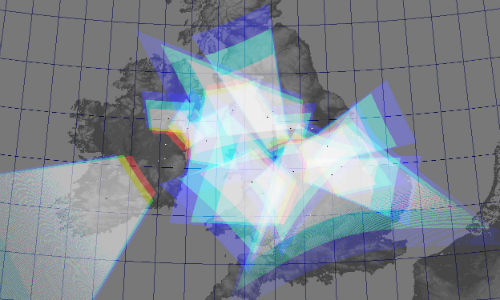
18th June 2014: A Bright One through the Twilight: This time of year is characterised by relatively few meteor captures, a result of the absence of major showers in the northern hemisphere, short nights and the fact that it never gets particularly dark up at our observing latitudes. This situation will begin to improve as we get past the summer solstice this weekend but in the meantime we picked up this relatively bright sporadic (magnitude -2.9) meteor that came in just to the east of the Isle of Man on 17th June 2014 at 00:17:00 BST. Again this is not far from where the meteors of 15th and 20th April came in (see below) - this particular part of the British Isles isn't especially favoured for meteors, it just so happens that we have good coverage over that region. Note that the Ravensmoor camera has been rotated clockwise through 90 degrees within its housing in order to minimise local overlap (see Nodes) and so what appears to be the bottom of the field of view is actually the left hand side.
All images and videos are available for individual personal use. The copyright resides with the authors and their written permission must be obtained in advance of any public and / or commercial use. |
||
24th May 2014: The Day After the Night Before: It was always going to be somewhat of a challenge for the Camelopardalids (CAMs) to live up to the hype and, somewhat predictably, reports from prime observing locations over North America suggest that rather than producing a storm (defined as a ZHR > 1000), they produced a more modest ZHR of between 5 and 10. The time of the maximum was predicted to occur between 06:00 and 08:00 GMT (after the sun rose here in the British Isles) and so hopes here were pinned on seeing a few early ones before daybreak. Alas the weather wasn't cooperative and all but two nodes were clouded out. Jeremy and William, based on Cheshire, were lucky enough to get two hours of clear skies between midnight and 02:00 GMT. Between them they detected 30 seperate meteors, none of which were multi-station captures.
The attached trail map is centred on the proposed radiant of 123.75, +79 - as can be seen, a number of trails pass close to it but there are none that one could say were definite CAMs. Of interest is the loosly defined radiant around 288, +88.
The other point of note is that the meteor trails were for the most part short and certainly in the case of the Ravensmoor Data, none appeared to have a particularly slow angular velocity which would be expected of CAMs, given their anticpated entry velocity of 19 km/s. There is therefore little convincing evidence that CAMs were detected. Addendum 27th May 2014: Bill Ward was able, by monitoring radio reflections, to detect two seperate peaks in activity - see here for details.
23rd April 2014: Latest Publication: An overview of meteor videography is given in the May 2014 issue of Astronomy Now magazine ...
20th April 2014: An Eggcellent Fireball on Easter Sunday: This maginitude -5.2 sporadic fireball came in just to the east of the Isle of Man on 20th April 2014 at 01:16:34 BST, not far from where the 15th April bright sporadic came in (see below). This one is interesting in that it exhibits a number of terminal flares (bright flashes, just before it disappears from view). In addition to being imaged by three NEMETODE cameras from Low Craighead, Leeds and Ravensmoor, Bill Ward also managed to get it too from Kilwinning - Bill's video is available here. Bill was out attempting to obtain spectra of Lyrid meteors - alas the diffraction grating in use to obtain spectra was aligned orthogonal to the Lyrid radiant, not the radiant of this fireball - as a consequence no spectra was recorded for this event. Bill is one of a very small number of people in the British Isles attempting to obtain and analyse meteor spectra. With the expanding NEMETODE coverage it's only a matter of time before we have trajectory and orbital data to compliment Bill's chemical composition data on a meteoroid. As ever with chance events such as these, it's a case of right time, right place, right equipment ... we should now add to this list right alignment of equipment! Note that the Ravensmoor camera has been rotated clockwise through 90 degrees within its housing in order to minimise local overlap (see Nodes) and so what appears to be the bottom of the field of view is actually the left hand side.
All images and videos are available for individual personal use. The copyright resides with the authors and their written permission must be obtained in advance of any public and / or commercial use. |
||
16th April 2014: Another Bright One: As the saying goes, you wait ages for one, then a couple come along in quick succession!. This bright sporadic came in just to the east of the Isle of Man on 15th April 2014 at 22:22:21 BST. The view from Leeds is on the left with meteor passing through the constellation Auriga while from Ravensmoor (shown on the right) it passed just to the left of Cassiopeia. Of note are the orbits derived from each station - they are almost exactly concurrent indicating this was a very precise observation. Note that the Ravensmoor camera has been rotated clockwise through 90 degrees within its housing in order to minimise local overlap (see Nodes) and so what appears to be the bottom of the field of view is actually the left hand side.
All images and videos are available for individual personal use. The copyright resides with the authors and their written permission must be obtained in advance of any public and / or commercial use. |
||
14th April 2014: We're Going to Need a Bigger Boat Map! Today we're happy to announce that Jeremy Shears has brought another camera system online (Watec 902H Ultimate with a Computar 12mm f0.8 lens) from his observatory in Bunbury, Cheshire. Jeremy's first camera faces south-east (upper camera in the picture below) while his second system (lower camera in the picture below) faces north and provides additional coverage over Lancashire and Yorkshire. This brings the total NEMETODE team to six nodes and ten permanently deployed cameras. Additional cameras and nodes are pending and of course the network is occasionally augmented with temporarily deployed units. There is still lots of sky that is not monitored adequately so anyone interested in participating is encouraged to get in touch. In the meantime, congratulations to Jeremy on his new arrival - just in time for the April Lyrids!
14th April 2014: Bright & Fragmenting through the Murk: Observing conditions on the evening of were far from ideal with a bright moon and thin cloud but in spite of these challenges NEMETODE cameras in Leeds and Ravensmoor picked up this sporadic meteor on 11th April 2014 at 21:19:10 BST. Not only was it bright enough to be seen despite the weather (note that very few stars are visible) but it is notable in that it displayed a distinct fragmentation event at the end of the trail. The NEMETODE magnitude estimate of 0.3 is likely to be an under-estimate. This meteor was also imaged by Martin Kessel from Weston Coyney, Stoke on Trent and was also seen visually from Haydock, Merseyside. Just a pity that the skies weren't clearer as this was a particularly good one. Note that the Ravensmoor camera has been rotated clockwise through 90 degrees within its housing in order to minimise local overlap (see Nodes) and so what appears to be the bottom of the field of view is actually the left hand side.
All images and videos are available for individual personal use. The copyright resides with the authors and their written permission must be obtained in advance of any public and / or commercial use. |
||
29th March 2014: Back from the Printers: Our latest paper, "Isle of Lewis Fireball of 2013 October 14", has now been published in the Journal of the British Astronomical Association - a .pdf is available here.
19th March 2014: Off to the Printers: Have just received confirming that one of our previously accepted papers, "Isle of Lewis Fireball of 14th October 2013" will appear in the April 2014 Issue of the JBAA - a .pdf will be available here following publication.
21st February 2014: NEMETODE gets another Segment: Today we're pleased to welcome Jeremy Shears to the NEMETODE team with the addition of his Watec 902H and Computar 3.8mm f0.8 lens operating from his observatory in Bunbury, Cheshire. Jeremy's system now allows multi-station coverage over western England, a region that was previously unavailable to us. This brings the total NEMETODE team to six nodes and nine permanently deployed cameras. Additional cameras and nodes are pending and of course the network is occasionally augmented with temporarily deployed units. There is still lots of sky that is not monitored adequately so anyone interested in participating is encouraged to get in touch. In the meantime a very warm welcome to Jeremy!
16th February 2014: Rock Star: We can now confirm that the event observed on 13th February was almost certainly a natural object and not a re-entering satellite. What initially sparked our interest was the fact that the geocentric velocity (ie the velocity with respect to the centre of the earth) was relatively low (5.5km/s). This is below the earth's escape velocity (11.2km/s) and could therefore be indicative of something that is (or was) in low earth orbit. The trajectory however was very unusual for a satellite (with an earth orbit inclination of circa 108 degrees). Further analysis showed that the atmospheric velocity was of the order of 12.5km/s which is higher than the earth's escape velocity ... the object must therefore have been in a heliocentric (sun-centred) orbit. The low geocentric velocity was a consequence of the object and the earth having similar orbital speeds and hence a low relative velocity as they caught up with each other (think relay racers passing on a baton). The derived solar orbit suggests the object may belong to the Apollo asteroid group of Near Earth Objects. We'd like to acknowledge the assistance of Cees Bassa, Ted Molzcan, Marco Langbroek and Jonathan McDowell for their analysis, comment and conclusions on this observation - all of which are very much appreciated.
14th February 2014: Potential Satellite Reentry? On the 13th February 2014 at 06:07:36 GMT NEMETODE cameras detected what appeared to be meteor - unusually it was particularly long lasting with a duration of over 12 seconds and magnitude of 0.1. We're still investigating this event as the low Vg (Geocentric Velocity) value suggests it may be man-made space debris. A significant note of caution is the fact that it travelled on a trajectory from north-east to south-west which is unusual for artificial satellites (most travel roughly west to east). Will post updates here as they become available. Click on the images below for videos / larger versions. Note that the Ravensmoor cameras have been rotated clockwise through 90 degrees within their housings in order to minimise local overlap (see Nodes) and so what appears to be the bottom of the field of view is actually the left hand side.
All images and videos are available for individual personal use. The copyright resides with the authors and their written permission must be obtained in advance of any public and / or commercial use. |
||
11th February 2014: Great Balls of Fire: While January 2014 has been one of the wettest on record for some parts of the British Isles, the northern half of the country seems to have escaped the worst of the floods. The clouds however have still been there and as a consequence the totals for the month are relatively low. February has seen a slight improvement, just in time for what is often referred to as "fireball season". Right on cue NEMETODE is starting to see an increase with the following sporadic being a borderline fireball at magnitide -4.0 recorded on 10th February at 04:26:46 GMT. We managed to get excellent orbital data on this one due to the orthogonal angles between the event and the observing stations in Leeds and Ravensmoor.
All images and videos are available for individual personal use. The copyright resides with the authors and their written permission must be obtained in advance of any public and / or commercial use. |
||
15th January 2014: Flash Bang Emergency: A very bright, slow moving meteor was detected on at least three NEMETODE cameras on 15th January 2014 at 18:45:16 GMT. Initial trajectory analysis suggests it became visible to the west of Anglesey, before heading on a east-north-east trajectory across the Irish Sea towards Blackpool. Visual observers are strongly encouraged to submit their reports to the Armagh Fireball Report Page. More to follow but in the meantime videos, further details and an analysis are available here.
It now seems probable that this bright meteor was responsible for the triggering and subsequent emergency response reported here and here. The sonic boom from the meteor could have been the loud noise reported by locals around 19:00 GMT as it would have taken approximately 10 minutes to reach South Wales. The bright meteor has been reported to the Coastguard at Milford Haven and they concur that it (currently) is the most likely explanation. ... individuals who believe they may have heard the sonic boom are requested to submit their report to the Armagh Fireball Report Page ... of particular interest will be their location and the precise time at which they heard the sound.
15th January 2014: New Year, New Journal Publication: Our latest paper, "The United Kingdom Fireball of 30th March 2013: Observation and Analysis using NEMETODE and Visual Data" has just been published in WGN, the Journal of the IMO 41:6 (2013, December) - click here for a copy. Videos of the fireball, together with larger images of the ground track and orbit are available here.
